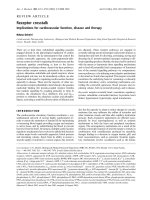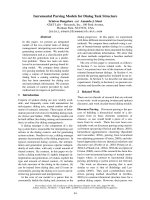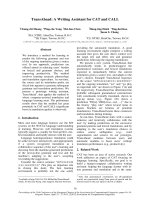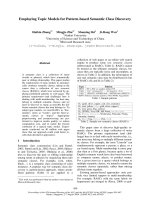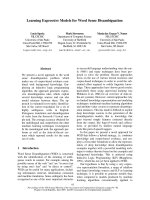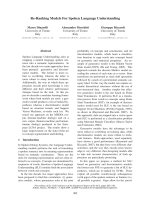Báo cáo y học: "New animal models for evolution and development" pdf
Bạn đang xem bản rút gọn của tài liệu. Xem và tải ngay bản đầy đủ của tài liệu tại đây (58.09 KB, 3 trang )
Genome Biology 2004, 6:303
comment
reviews
reports
deposited research
interactions
information
refereed research
Meeting report
New animal models for evolution and development
Kristin Tessmar-Raible and Detlev Arendt
Address: European Molecular Biology Laboratory, Meyerhofstrasse 1, 69012 Heidelberg, Germany. E-mail: ;
Published: 21 December 2004
Genome Biology 2004, 6:303
The electronic version of this article is the complete one and can be
found online at />© 2004 BioMed Central Ltd
A report on the annual UK Evolutionary Developmental
Biology meeting, Oxford, UK, 13 September 2004.
To resolve the puzzle of metazoan evolution and development,
bioinformatic and experimental approaches must be applied
to a wider range of species than just the standard model
organisms. This was reflected in the list of phyla covered in
this year’s ‘Evo-Devo’ meeting organized by David Ferrier
and Peter Holland (both at the University of Oxford, UK).
Much of our understanding of metazoan evolution and devel-
opment (evo-devo) is based on comparisons of the model
organisms Caenorhabditis elegans and Drosophila
melanogaster with the vertebrates - but such comparisons
have two main limitations. First, they cannot tell us where
metazoan genes come from, or what their original role was in
our unicellular ancestors. To try to answer this question, the
unicellular choanoflagellates have now come on to the molec-
ular stage. Second, evidence is accumulating that both
Drosophila and C. elegans are fast-evolving organisms, have
lost many ancestral genes, and have modified development
more than other bilaterans. Needless to say, this complicates
evolutionary studies. The meeting drew our attention to
studies on crustaceans, the wasp Nasonia and the polychaete
Platynereis that have shed new light on the evolution of seg-
mentation, axis formation and eye development, respectively.
Many genes in multicellular animals, such as those for cell
adhesion proteins, intercellular signaling proteins, extracellu-
lar matrix components and certain families of transcription
factors, have no similarities to any known genes in plants or
fungi. Their evolutionary origin is thus entirely unclear. In his
talk, Holland reasoned that in order to gain more insight into
the origins of metazoan proteins and body plans, it is crucial
to sequence the genomes of animals that have branched off
the evolutionary tree immediately before, or immediately
after, the advent of multicellularity. Species thus selected for
genome sequencing by the Joint Genome Institute in the USA
and for the generation of vast collections of expressed
sequence tags (ESTs) are unicellular choanoflagellates (two
unrelated Monosiga species), the amorphous, basal meta-
zoan Trichoplax, the sponge Reniera (Demonspongia) and
the polyp Nematostella (Anthozoa, Cnidaria).
Holland focused on progress in studying the unicellular
choanoflagellates, which are considered the sister group (the
closest relatives) of all metazoan animals, a view initially
proposed on the basis of morphological comparisons dating
back to the nineteenth century. This key phylogenetic posi-
tion of choanoflagellates has now been confirmed by
Holland and co-workers using a total of 30,000 amino acids
of concatenated protein sequence for phylogenetic tree con-
struction. Choanoflagellate EST sequences are currently
yielding nice examples of how knowledge of the genes and
proteins present in basal groups can further enhance our
understanding of the origins of metazoan genes and pro-
teins. Besides helping us to understand the origins of meta-
zoan genes, the sequencing of choanoflagellates, placozoa,
sponges and anthozoans will also reveal general mechanisms
acting in gene evolution.
Distinguishing one end from the other
Claude Desplan (New York University, New York, USA)
reported on an apparent example of convergent evolution in
the patterning of the anterior-posterior axis in insects. His
group compared anterior-posterior patterning in Tribolium
(a beetle), a so-called short germ-band insect that forms the
segments sequentially, and in Drosophila and Nasonia (a
parasitic wasp), both of which are long germ-band insects
(forming the segments simultaneously). Desplan argued that
an ancestral mode of anterior-posterior patterning acting in
short germ-band insects involved the anteriorly acting genes
otx and hunchback (hb), which counteracted the action of
caudal at the posterior end. The developing Drosophila
embryo has departed considerably from this scenario by
establishing an anterior morphogenetic center that uses a
gradient of maternally supplied bicoid (bcd) mRNA, which
establishes the correct sequence of anterior-to-posterior identi-
ties all at once. This is possible because Drosophila is a long
germ-band insect with simultaneous segment formation.
However, bicoid is a phylogenetically young gene that evolved
late and only in flies. It does not exist in other long-germ band
insects, not even in the mosquito Anopheles, a close relative of
flies. How then do other long germ-band insects establish their
anterior-posterior axis?
Desplan reported that in order to answer this question
Jeremy Lynch in his lab investigated the role of hb and otx in
anterior axis specification in Nasonia, a long germ-band
hymenopteran whose lineage departed from that of the flies
220 million years ago (Mya). Interestingly, otx mRNA in
Nasonia is localized at both the anterior and posterior poles
of the egg. Inactivation of the otx gene by parental RNA
interference (RNAi) produces headless embryos, indicating
that otx has a bicoid-like role in patterning the anterior of
Nasonia. RNAi of otx also causes significant disruptions in
posterior segmentation.
In the beetle Tribolium, hb is not required for the develop-
ment of the anterior-most head segments, but in Nasonia,
in contrast, a zygotic mutation in hb (generated by Mary
Anne Pultz, Western Washington University, Bellingham,
USA) deletes almost the entire anterior end of the animal.
This indicates that in Nasonia, hb functions as a major
player, and that the otx-hb interaction in anterior pattern-
ing in Nasonia is as strong as, or stronger than, the analo-
gous interaction of bcd and hb in the fly. Desplan proposed
that, like Drosophila, Nasonia has independently evolved
an anterior morphogenetic center by localizing otx at the
anterior (and the posterior) end of the embryo to take
advantage of, or to make possible, its long germ-band mode
of development.
Michalis Averof (Institute of Molecular Biology and
Biotechnology (IMBB), Crete, Greece) presented an analysis
of the posterior patterning gene caudal (cad) in crus-
taceans and a comparison of its function across different
phyla. In the brine shrimp Artemia, cad expression specifi-
cally localizes to the posterior growth zone. Moreover,
Averof reported that Tijana Copf in his lab had shown that
cad inactivation by RNAi in the larva can abolish all trunk
segments, depending on the time of the interfering RNA
injection. At the molecular level cad inactivation leads to
severe perturbation of expression of the early segmentation
genes engrailed and even-skipped. Averof’s group, together
with Reinhard Schröder’s group at the University of Tübin-
gen (Germany), found that interference with cad function
similarly abolishes trunk segment formation in the beetle
Tribolium. This implies that, in the most recent common
ancestor of crustaceans and insects, segments were already
being formed from a posterior growth zone under the
control of cad.
As Averof pointed out, this role of cad also extends beyond
the protostomes (the wider phylogenetic branch to which
insects belong). In vertebrates, which are deuterostomes, cad
orthologs (cdx1-cdx4) are expressed in the caudal presomitic
mesoderm, where they are required for the segmental genera-
tion of the somites and the specification of somite identity.
Mutations in the vertebrate cdx genes also compromise the
self-renewing capacity of the presomitic mesoderm. There-
fore, it appears that the function of cad in the growth zone
and in posterior segmentation is ancestral for bilaterians
(animals with bilateral symmetry, including both insects and
vertebrates).
Averof also reported work of Tassos Pavlopoulos in his group
who has succeeded in establishing transgenesis in the amphi-
pod crustacean Parhyale hawaiiensis by injecting DNA into
one-cell and two-cell embryos. He used a vector containing
the minos transposable element from Drosophila hydei
(developed by C. Savakis, Institute of Molecular Biology and
Biotechnology, Crete, Greece). This vector appears to have
the potential to function in a wide range of phyla.
Tracing origins
To determine homology between organs in different species,
morphologists have in the past mainly focused on the struc-
ture of the organ as a whole. Organs are, however, composite
structures of distinct tissues, each of which is composed of
one or more cell types, and each cell type will have its own
evolutionary history. The comparison of cell types from dif-
ferent species is thus a novel and useful approach to deter-
mining the evolution of organs. One of us (D.A.) described
work from our lab that takes this approach to bilaterian eye
evolution, comparing the photoreceptor cells of vertebrates
with those of the polychaete Platynereis dumerilii, a marine
invertebrate selected for genome and large-scale EST
sequencing by the French national sequencing centre Géno-
scope. On the basis of evidence from sequence analysis,
developmental gene expression and cellular ultrastructure
we proposed that the rods and cones, the ciliary photorecep-
tors of the vertebrate retina, derive from a population of
ciliary photoreceptor cells that was present in the brains of
ancient bilaterians.
It has been estimated that more than half of all known
animal species are parasitic at some stage of their life cycle
and Tim Littlewood (Natural History Museum, London, UK)
addressed the question of how the complex life cycles of par-
asites evolve, focusing on tapeworms and liver flukes. To be
a successful parasite, the interaction between host and para-
site must be finely balanced. Parasites have to circumvent
the host’s immune response and to adapt their life cycles to
attach to or enter their hosts, as well as to use the resources
provided optimally. Parasites may influence the host’s
behavior and development for their own advantage, but the
balance between cost to the host and benefit to the parasite
303.2 Genome Biology 2004, Volume 6, Issue 1, Article 303 Tessmar-Raible and Arendt />Genome Biology 2004, 6:303
is often finely tuned as, for example, expressed in the Red
Queen hypothesis of host-parasite coevolution. Some of
these interactions are especially interesting because of the
very complicated parasite life cycles, where up to seven dif-
ferent hosts may be used.
Littlewood has started to achieve a better resolution of the
phylogeny of the main platyhelminth groups and the con-
stituent parasitic taxa, from which ancestral life cycles, and
therefore evolutionary development, of the parasites can be
inferred. The evolution of obligate parasitism in the phylum
was a major single event but unpicking the way in which it
arose and how each major parasitic lineage and the various
life history and developmental strategies radiated requires a
combination of phylogenetics, comparative life-cycle data
and the need to perceive these life cycles in a more develop-
mental, rather than ecological, sense.
It is clear that the morphological changes that occur during
evolution are ultimately encoded at the DNA level. But
where exactly in the genome do evolutionarily significant
mutations occur? So far, enhancers have been the main
focus of attention. Claudio Alonso and Adam Wilkins (Uni-
versity of Cambridge, UK) moved away from what they
called “the enhancer cult”, and instead emphasized the pos-
sible evolutionary importance of changes in regulatory ele-
ments other than enhancers. They presented a synopsis of
the many different mechanisms now known to control
mRNA and protein levels, including the tissue-specific
expression of components of the basic transcriptional
machinery, the different sequences of core promoters of dif-
ferent genes, and the control of gene expression via mRNA
untranslated regions. Alonso and Wilkins also stressed the
possible evolutionary importance of alternatively spliced
transcripts. Their examples showed that ratios between the
splicing isoforms of certain genes could be critical for
normal development, and that unique protein domains
introduced by tissue-specific alternative splicing could lead
to distinct gene functions in different cell types. They argued
that mutations affecting all these alternative regulatory
points could potentially be as important as those that affect
enhancers in regulating developmental gene activity. It will
be interesting to investigate whether, for example, certain
splicing variants of developmental genes are more evolution-
ary conserved than others, and if and how these differences
might cause changes in the morphology of different species.
Although short, the meeting reflected well how information
from non-model organisms leads to exciting questions and
results that yield a broader comprehension of development and
evolution. It has become clear that this understanding cannot
be achieved by relying only on the classical model organisms.
comment
reviews
reports
deposited research
interactions
information
refereed research
Genome Biology 2004, Volume 6, Issue 1, Article 303 Tessmar-Raible and Arendt 303.3
Genome Biology 2004, 6:303

